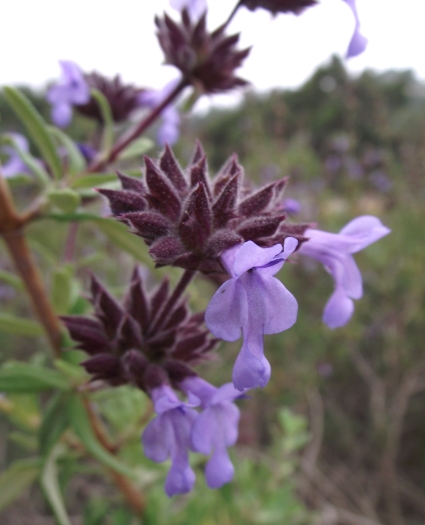Santa Rosa Island Sage
(Salvia brandegeei)
Santa Rosa Island Sage (Salvia brandegeei)
/
/

Stickpen
CC0
Image By:
Stickpen
Recorded By:
Copyright:
CC0
Copyright Notice:
Photo by: Stickpen | License Type: CC0 | License URL: http://creativecommons.org/publicdomain/zero/1.0/deed.en | Uploader: Stickpen | Publisher: Wikimedia Commons | Title: Salvia_brandegeei.jpg |





















Estimated Native Range
Summary
Salvia brandegeei, commonly known as Santa Rosa Island Sage, is an evergreen shrub or subshrub native to the coastal sage scrub and chaparral of Santa Rosa Island, part of the Channel Islands in California, and also found in Baja California. It typically grows to a height greater than 1 meter and can adopt a prostrate form. This species is characterized by its dark green, scalloped leaves and showy pale lavender flowers that bloom in tightly spaced whorls. The violet-gray calyx and wide-open flower lips contribute to its ornamental appeal, particularly when it flowers from late winter to early spring.
Santa Rosa Island Sage is valued for its drought tolerance, making it an excellent choice for xeriscaping and water-wise gardens. It is also appreciated for its aromatic foliage and its ability to attract pollinators such as bees and hummingbirds. In cultivation, it can reach 4–5 feet in height and spread up to 7 feet (2.1 m) wide. It thrives in full sun and can grow in a variety of soil types, including sandy and clay soils, as long as they have good drainage. It is cold-hardy to 0 °F for brief periods. This plant is often used in native plant gardens, as an informal hedge, or in mass plantings for erosion control on slopes. While generally low-maintenance, it can be susceptible to root rot if overwatered or planted in poorly drained soils.CC BY-SA 4.0
Santa Rosa Island Sage is valued for its drought tolerance, making it an excellent choice for xeriscaping and water-wise gardens. It is also appreciated for its aromatic foliage and its ability to attract pollinators such as bees and hummingbirds. In cultivation, it can reach 4–5 feet in height and spread up to 7 feet (2.1 m) wide. It thrives in full sun and can grow in a variety of soil types, including sandy and clay soils, as long as they have good drainage. It is cold-hardy to 0 °F for brief periods. This plant is often used in native plant gardens, as an informal hedge, or in mass plantings for erosion control on slopes. While generally low-maintenance, it can be susceptible to root rot if overwatered or planted in poorly drained soils.CC BY-SA 4.0
Plant Description
- Plant Type: Shrub
- Height: 4-5 feet
- Width: 5-7 feet
- Growth Rate: Rapid
- Flower Color: Blue, Purple
- Flowering Season: Spring, Summer
- Leaf Retention: Evergreen
Growth Requirements
- Sun: Full Sun
- Water: Low
- Drainage: Medium
Common Uses
Bank Stabilization, Bee Garden, Bird Garden, Border Plant, Butterfly Garden, Deer Resistant, Drought Tolerant, Fragrant, Hummingbird Garden, Low Maintenance, Rabbit Resistant, Salt Tolerant, Showy Flowers
Natural Habitat
Native to coastal sage scrub and chaparral on Santa Rosa Island and in Baja California
Other Names
Common Names: Brandegee’s Sage
Scientific Names: Salvia brandegeei , Audibertia stachyoides var. revoluta
GBIF Accepted Name: Salvia brandegeei Munz